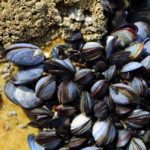Paper, Safe and Sustainable Wood Glue Inspired by Mussels
Most wood glues use formaldehyde, which is toxic and not sustainable. “When these formaldehyde-based adhesives are used in the production of plywood and particle board, formaldehyde is released in a process called off-gassing,” which can cause irritation and affect the long-term health of people with frequent exposure. “Formaldehyde-based resins are also created using fossil fuels,” so the industry really needs to consider safer and sustainable alternatives.
Dr. Kaichang Li is a wood science researcher who happened to notice the adhesive abilities of blue mussels when he was fishing in Oregon. He already had an interest in non-toxic wood materials, and observing the mussels gave him an idea. Li was inspired by the byssal threads of blue mussels, which allow them to cling tightly onto rocks, to create a sustainable and non-toxic glue. However, the marine adhesive protein turned out to be expensive and not accessible.
Li discovered that soy protein has similar features and created a soy-based wood glue that was non-toxic, sustainable, and cheap, but not strong or water-resistant, so durability was added to the criteria. He partnered with Columbia Forest Products and Hercules Inc. to create a wood glue that met all criteria, and after many tests, they eventually designed a low-cost, soy-based, high-strength, water-resistant, non-toxic glue technology called PureBond.
Learn about our two Decals!
 Click here to find out more about our Fall Bioinspired Design Decal and our Spring Bioinspired Design in Action Decal – ALL MAJORS are welcome.
Click here to find out more about our Fall Bioinspired Design Decal and our Spring Bioinspired Design in Action Decal – ALL MAJORS are welcome.Berkeley BioDesign Community
 Click here to learn about the BioD: Bio-Inspired Design @ Berkeley student organization or here to signup for more info.
Click here to learn about the BioD: Bio-Inspired Design @ Berkeley student organization or here to signup for more info.Search
Student Login





I imagine that the neurological circuits underlying these processes are governed by both 2d spacing maps with their brains as…
to reduce the impact of car accidents, it may be possible to study the force diverting physics of cockroaches to…
you see this type of head-bobbing stability in many avian creatures related to pigeons like chickens. the head ability to…
not like they taught horses how to run! this is an example of convergent evolution where both sea creatures and…
The brain functions in a similar way with neuronal connections. our brains are able to utilize the multiplicity of connections…